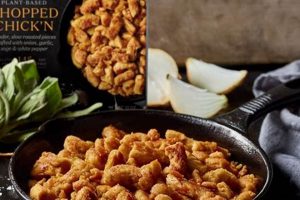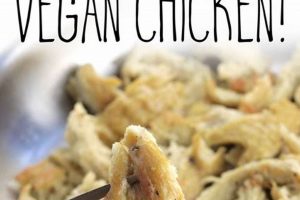This dish represents a plant-based adaptation of a popular Chinese-American takeout item. It typically involves preparing a protein substitute, such as tofu or seitan, coating it in batter, frying or baking it, and then tossing it in a sweet and tangy citrus-based sauce. The result is a flavorful and texturally appealing meal appealing to those seeking alternatives to animal-based cuisine.
The appeal of this culinary approach lies in several factors. It offers a way to enjoy familiar comfort food while adhering to dietary restrictions or ethical considerations. The consumption of plant-based meals is often associated with health benefits, including lower cholesterol and reduced risk of certain diseases. Furthermore, the creation of this dish can encourage culinary experimentation and innovation in the plant-based cooking sphere.
The following sections will delve into the various components involved in crafting this delectable meal, including protein selection, sauce preparation techniques, and cooking methods, thereby providing a guide for successful replication.
Essential Preparation Guidelines
The successful execution of a plant-based citrus-infused poultry alternative relies on meticulous attention to several critical aspects. Proper ingredient selection and precise execution are paramount.
Tip 1: Protein Selection. Tofu, specifically the extra-firm variety, requires pressing to eliminate excess moisture. This process enhances the protein’s ability to absorb flavors and achieve a desirable crispy texture during cooking. Seitan, another suitable option, should be prepared or purchased with a firm, slightly chewy consistency.
Tip 2: Batter Consistency. The batter, commonly composed of flour, cornstarch, and spices, must possess a balanced consistency. A batter that is too thin will result in inadequate coating, while an excessively thick batter may yield a heavy, undesirable crust. A medium-thick batter, akin to pancake batter, is generally recommended.
Tip 3: Cooking Method. Both frying and baking are viable options. Deep-frying produces a crisper result, but baking, at a high temperature (e.g., 400F or 200C), can achieve a similar effect with reduced oil usage. Air frying presents a convenient alternative.
Tip 4: Sauce Preparation. The citrus-based sauce should strike a balance between sweetness, acidity, and umami. Freshly squeezed citrus juice is preferable to concentrate. Soy sauce or tamari contributes umami, while sweeteners such as maple syrup or agave nectar can be adjusted to preference.
Tip 5: Sauce Consistency. A cornstarch slurry is typically employed to thicken the sauce. Gradual addition of the slurry, while stirring, allows for precise control over the final consistency. The sauce should be thick enough to coat the protein without becoming gummy.
Tip 6: Sauce Application. The cooked protein should be added to the sauce immediately before serving. Prolonged exposure to the sauce can soften the protein’s crispy exterior, diminishing the overall textural experience.
Tip 7: Garnish Considerations. Sesame seeds, scallions, and red pepper flakes are commonly used garnishes. These additions contribute visual appeal and enhance the flavor profile of the finished dish.
Adhering to these guidelines enhances the likelihood of achieving a palatable and visually appealing dish. Careful execution results in a flavorful and satisfying plant-based alternative to a classic dish.
The subsequent section presents detailed ingredient lists and step-by-step instructions for the successful implementation of these techniques.
1. Protein Source Selection
Protein source selection forms a cornerstone in the creation of plant-based citrus-infused poultry alternatives. The choice of protein not only dictates the dish’s nutritional profile but also profoundly influences its texture, flavor absorption, and overall palatability. The absence of animal-derived protein necessitates a strategic approach to replicating the desired characteristics of the original dish. For example, using silken tofu, without modification, would lead to a structurally unstable and texturally unappealing result; in contrast, properly pressed extra-firm tofu provides the necessary density and allows for browning, mimicking the exterior of traditional preparations.
Different protein sources exhibit varying affinities for the citrus sauce. Seitan, known for its gluten-based composition, readily absorbs the sauce, resulting in a more intensely flavored product. However, its naturally chewy texture may not appeal to all consumers. Tofu, on the other hand, requires careful preparation to enhance its absorption capabilities. Coating the tofu in cornstarch before frying creates a slightly porous surface that effectively holds the sauce. The decision hinges on the desired textural outcome and the preferred intensity of the citrus flavor infusion.
In conclusion, protein selection is not merely a substitution exercise but a critical element demanding informed consideration of textural properties, flavor absorption, and overall structural integrity. The informed selection and careful preparation of the protein source dramatically affects the success and enjoyment of the dish. Selecting the best source contributes to the overall experience.
2. Citrus Sauce Composition
The citrus sauce forms the definitive characteristic of the dish. Its composition directly determines the flavor profile, establishing the balance between sweetness, acidity, and umami that defines the dish. Variations in ingredient ratios directly impact the final taste. An overabundance of citrus juice creates an excessively tart flavor, while insufficient sweetness yields an unbalanced and unpalatable result. The inclusion of umami elements, often derived from soy sauce or tamari, provides depth and complexity, preventing the sauce from being merely a simple sweet-and-sour concoction. The thickening agent, typically cornstarch, dictates the sauce’s viscosity, influencing its ability to cling to the protein and provide a satisfying coating. The selection of sweetener, ranging from refined sugar to maple syrup, introduces subtle nuances to the overall flavor profile.
Practical examples illustrate this point. A sauce relying heavily on orange concentrate, without adequate fresh juice, tends to lack the brightness and complexity associated with the dish. The absence of a thickening agent results in a thin, watery sauce that fails to adequately coat the protein, diminishing the textural experience. Experimentation with different types of citrus juices, such as mandarin or blood orange, allows for subtle variations in flavor, catering to individual preferences. The inclusion of aromatics, like ginger or garlic, adds layers of complexity, elevating the sauce beyond a basic sweet-and-sour formulation.
In summary, citrus sauce composition represents a crucial determinant of quality. Mastering the balance of key components is essential for the successful creation of this dish. Challenges arise in achieving consistent results due to variations in ingredient quality and individual taste preferences. Accurate measurement and meticulous adjustment are necessary to overcome these challenges and achieve the desired flavor profile. This detailed understanding of sauce composition is crucial for both culinary professionals and home cooks seeking to replicate the intended flavor accurately.
3. Texture Development Technique
The success of a plant-based citrus-glazed “chicken” dish hinges significantly on the skillful implementation of texture development techniques. Achieving a palatable and appealing result necessitates replicating the crispy exterior and tender interior characteristic of the traditional poultry-based dish. Failure to address the textural aspects can lead to a final product that is unappetizing, regardless of the quality of the sauce or other components. The relationship between texture and the overall dining experience is paramount; an otherwise flavorful dish can be rendered unsatisfying by an inadequate or unappealing texture. The appropriate techniques vary dependent on the selected protein source. For tofu, pressing to remove excess moisture followed by coating in cornstarch and either frying or baking is typically employed. Seitan, with its inherently chewier texture, may require different strategies, such as scoring the surface to increase crispness or steaming prior to other cooking methods to achieve a more tender interior.
Real-world examples illustrate the importance of technique. Tofu that has not been adequately pressed will steam rather than fry, resulting in a soggy and unappetizing final product. Similarly, seitan that is not properly prepared can be overly dense and difficult to chew. The choice of cooking oil and temperature also plays a crucial role; using an oil with a low smoke point or frying at an insufficient temperature can lead to a greasy and under-crisped exterior. Experimentation with different coating methods, such as the addition of rice flour or panko breadcrumbs, can further enhance the textural complexity of the dish. Employing a double-frying method, similar to that used in the preparation of some fried chicken dishes, may also be beneficial in achieving maximum crispness. An adequate level of dryness during the cooking process helps to get good crust.
In conclusion, texture development is an indispensable element in the creation of a convincing and delicious plant-based citrus-glazed poultry alternative. Understanding the specific properties of the chosen protein source and applying appropriate cooking techniques are crucial for achieving the desired textural outcome. Mastering these techniques not only elevates the dish but also broadens the appeal of plant-based cuisine. Improper textural treatment can dramatically reduce the dish’s value.
4. Flavor Profile Balance
Flavor profile balance is a critical determinant of success in the preparation of a plant-based version of the citrus-glazed poultry dish. The objective is to achieve a harmonious interplay of sweet, sour, savory (umami), and potentially spicy notes. Imbalances in these flavor elements lead to a diminished and ultimately unsatisfying culinary experience. For instance, a sauce that excessively emphasizes sweetness masks the citrus notes and lacks depth. Conversely, an overabundance of acidity can be overwhelming, rendering the dish unpalatable. Therefore, a deliberate and measured approach to flavor calibration is essential.
Achieving this balance requires careful selection and proportioning of ingredients. Citrus juice, typically orange, forms the acidic base. Sweeteners, such as agave or maple syrup, temper the acidity and contribute viscosity. Soy sauce or tamari introduce umami, providing a savory counterpoint to the sweetness and acidity. Chili flakes or a dash of hot sauce can introduce a spicy dimension, further enhancing complexity. The absence or miscalibration of any one of these components disrupts the overall flavor harmony. Real-world examples underscore this point. A sauce lacking sufficient soy sauce may taste flat and one-dimensional. An excess of chili flakes can overshadow the other flavors, creating an imbalance that detracts from the intended taste profile. Thorough taste-testing throughout the cooking process is imperative, allowing for adjustments to ensure optimal flavor balance. The individual components’ quality also significantly affects the final profile; using fresh-squeezed orange juice, as opposed to concentrate, greatly contributes to a brighter, fresher taste. The specific soy sauce brand can introduce subtle variations, for example, the difference between dark and light soy sauce in sodium, salt, sugar and color.
In summary, flavor profile balance functions as a cornerstone of the plant-based citrus poultry dish. Careful consideration must be given to each ingredients contribution and how it interplays with others. The challenge lies in achieving a consistent result, given the variability of ingredients and individual taste preferences. Meticulous measurement, ongoing taste assessment, and a willingness to adjust the recipe are essential for achieving the desired flavor harmony. This focus on balancing flavor enhances the satisfaction and wider adoption of this meal alternative. Understanding flavor dynamics and balance is key.
5. Presentation and Garnishing
The visual appeal of any culinary creation significantly impacts the dining experience. In the context of a plant-based citrus-glazed poultry alternative, meticulous attention to presentation and garnishing elevates the dish from a simple meal to a visually engaging and palatable offering. This consideration transcends mere aesthetics; it enhances perceived value and contributes to overall satisfaction.
- Color Palette Harmony
The strategic use of color contributes to visual appeal. The vibrant orange hue of the sauce, contrasted with the neutral tones of the protein and the verdant accents of garnishes, creates a visually stimulating composition. Garnishes such as scallions or cilantro provide a fresh, contrasting color that complements the richness of the sauce. Bell pepper adds brightness and texture. Color balance influences perceived tastiness and freshness.
- Texture Contrast
Juxtaposing textural elements enhances the sensory experience. A sprinkle of sesame seeds provides a subtle crunch, contrasting with the tenderness of the protein and the smoothness of the sauce. Finely chopped nuts, such as peanuts or cashews, introduce additional textural complexity. Garnishes also play a role in visual separation. The interplay of textures, from the crispy protein to the soft sauce and the crunchy garnish, makes eating the dish a satisfying physical sensation.
- Plate Composition and Arrangement
The manner in which the components are arranged on the plate influences the overall visual impact. A carefully arranged dish, with elements strategically positioned to highlight their individual qualities, appears more appealing than a haphazardly assembled one. Avoiding overcrowding ensures each component remains visually distinct. The use of strategic spacing can create a visually balanced and appealing presentation.
- Garnish Functionality and Edibility
Garnishes should not merely serve an aesthetic purpose; they should also be edible and complementary to the dish’s flavor profile. Sesame seeds contribute a nutty flavor, while scallions offer a mild onion-like taste. Avoid non-edible or overpowering garnishes that detract from the intended flavors. Selecting garnishes that enhance both the visual appeal and the flavor profile demonstrates a thoughtful and refined approach to presentation.
In conclusion, the attention to presentation and garnishing contributes substantially to the overall success of the citrus-infused plant-based poultry substitute. Strategic utilization of color, texture, plate composition, and functionality enhances the dishs appeal, making it a satisfying and visually compelling culinary experience. The conscious effort to beautify each element can transform the final product. These components influence consumption enjoyment.
Frequently Asked Questions
The following section addresses common inquiries and misconceptions surrounding the creation and consumption of a plant-based citrus poultry alternative.
Question 1: What protein sources are most suitable for replicating the texture of chicken in this dish?
Extra-firm tofu, properly pressed to remove excess moisture, and seitan, prepared to achieve a firm but slightly chewy consistency, are both viable options. Other vegetable proteins are also appropriate.
Question 2: Can frozen orange juice concentrate be substituted for fresh orange juice in the sauce?
While concentrate can be used, freshly squeezed orange juice is generally recommended for a brighter, more nuanced flavor. The choice of orange juice effects the final product.
Question 3: Is it necessary to deep-fry the protein, or are there healthier alternatives?
Deep-frying yields a crispier result, but baking at a high temperature (approximately 400F or 200C) or air-frying provide healthier alternatives that can achieve a similar level of crispness. Alternative cooking methods exist.
Question 4: What thickening agents are suitable for the citrus sauce besides cornstarch?
Arrowroot powder or tapioca starch can be used as alternatives to cornstarch, offering similar thickening properties. The effect is consistent across these options.
Question 5: How can the sauce be adjusted to accommodate different dietary restrictions, such as gluten intolerance?
Tamari can be substituted for soy sauce to create a gluten-free version of the sauce. Be mindful of sodium content when making this swap.
Question 6: What are the best methods for storing leftovers to maintain optimal texture and flavor?
Storing the protein and sauce separately is advised to prevent the protein from becoming soggy. Reheat both components independently and combine just before serving. Storage techniques influence final quality.
In summary, successful adaptation of this recipe hinges on thoughtful ingredient selection, appropriate cooking techniques, and consideration of dietary restrictions.
The subsequent section offers a detailed, step-by-step recipe for creating the dish.
Concluding Remarks
This exploration of the vegan orange chicken recipe has illuminated the multifaceted considerations involved in its successful execution. From protein selection and sauce composition to texture development and flavor balancing, the process demands attention to detail and a thorough understanding of ingredient interactions. The presented information serves as a guide for achieving a palatable and visually appealing result, transforming a traditionally animal-based dish into a satisfying plant-based alternative.
The continued refinement of the vegan orange chicken recipe and plant-based culinary techniques promises a future where ethical and dietary choices no longer necessitate a compromise in flavor or enjoyment. Readers are encouraged to apply this knowledge, experiment with variations, and contribute to the ongoing evolution of plant-based cuisine. Consistent and refined application of techniques promotes quality improvement.







